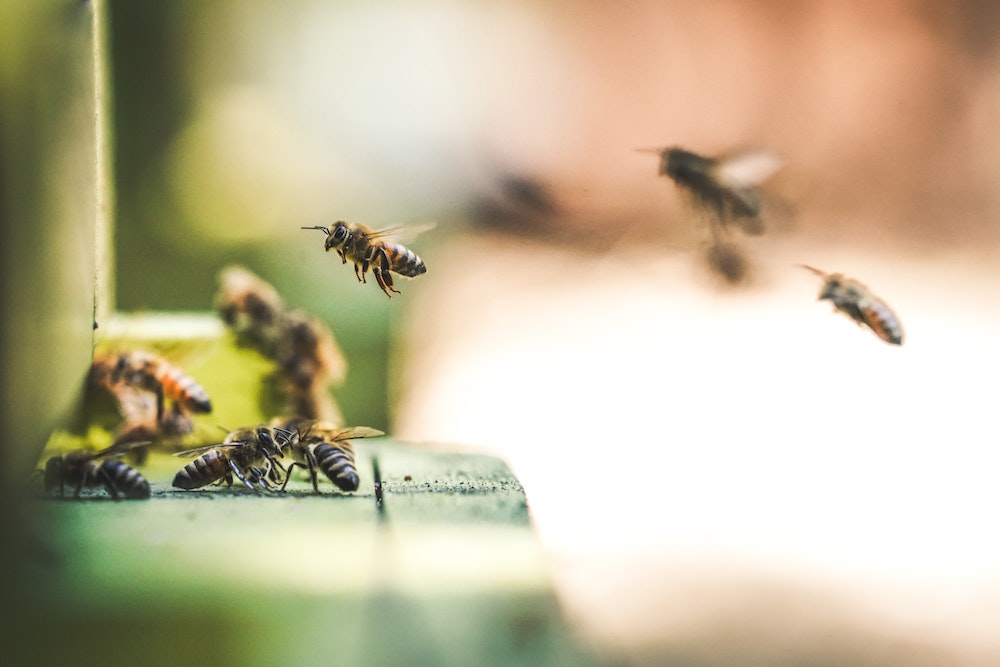Bees are incredible insects with unbelievable survival skills, including their uncanny olfactory sense and their seamless communication among colonies, sending clear messages through what appears to be a simple wag dance. However, as bee behavior is studied more, the complexity of these fantastic pollinators continues to impressively unfold. It may be assumed that bees can find their homes by recollection, but it is more purposeful than that, and it begins with flying in reverse as they leave the hive for the first time of the day to note landmarks and other identifiers to get them back to the correct spot.
How Nesting Bees Relocate
At the beginning of each foraging day, nesting bees take an orientation flight as they leave the nest for the first time. This flight, considered by Nico Tinbergen as instinct, has been repeatedly observed to be a back-and-forth, or zig-zag style flight when first leaving the nest. The more interesting thing is that they fly backward, keeping the nest in the site as they identify different landmarks to help them return. Landmarks may include rocks, plants, irregularities, and other visible signs so nesting bees can relocate the nest. As bees get further from the nest, they get higher above the ground, giving them a broader view.
Bees take these orientation flights each day because the landscape may change daily for a variety of reasons, including human activity like mowing lawns, cutting or pruning down trees, or moving other landmarks bees may use. It is always wise to think about how our actions may be impacting critical pollinators, but this does not mean we have to stop our activities; we can just be thoughtful.
Placing Water for Bees on the Flight Path
When some hear about placing a water source for bees in their flight path, they may scoff, thinking there would be no way to tell the flight path. On the contrary, bees like routine, which is why beekeeping is so appealing. Bees use the same flight unless something obstructs it or something else in the environment changes; in most cases, bees will take the same orientation flight in the same path each new day, making placing water in their way easy to do. It is helpful for bees because they need lots of water and it can become a landmark for them to use a reference to get home safe!
Solitary v Social Bees
Most people do not realize that more than 75% of bees are solitary, so they don't have a large nest to return to each day they forage. Solitary bee nests are run by a female who builds and defends her nest as she lays eggs and collects pollen without help. Talk about girl power! Solitary bees most often nest in or near the ground, maybe in a dead fallen tree.
Social bees make up less than 10% of bee species, and these social nesters live in colonies and all bees will cater to the queen as she solely provides for all baby bees in her lifetime. Social queen bees do not forage or defend the hive, which is one of the significant differences between social and solitary bees. Once the queen stops emitting potent pheromones or eggs begin to decline in numbers, she is replaced, and bees will begin to raise new queen candidates. Swarming establishes a new nest site and may also be caused by overcrowding.
Honeybees are one of the most well-known bee species. They live in large colonies and make delicious honey. Honeybees are the most common bee species for beekeepers because they enjoy the caretaking and any excess honey they harvest.
Bumblebees and carpenter bees are social but live in smaller temporary colonies where two adult females cooperate, and labor is divided. Although the males don't seem to have much of a role, they do have shorter life spans and exist only to reproduce. Male bees have been observed courting female bees to increase their value and be sought-after mates. It is thought that female bees have a role in choosing their mate, which only happens once in flight.

Get help with your beehive or bee swarm removal! Call Today 760-224-3040 Or 951-265-8292!
What About the Other 15% of Bees?
The remaining bees are brood parasites. They do not forage or nest. The female bee enters a vacated nest, lays an egg, and then leaves. When the parasites hatch, they kill the nest host and eat the pollen they brought back. Brood parasites look similar to wasps and have large mandibles that they happily use to kill larvae! As if bees don’t have enough threats from Varroa mites and other threats, they must deal with their kind invading their nests and taking their food!
Learning more about bees and raising awareness of their behaviors and critical value in pollination encourage the humane treatment of bees. If you ever face a bee concern, contact D-Tek for an inspection, humane bee removal, or some fresh, local honey. Call us today at 760-224-3040!
